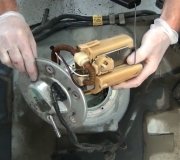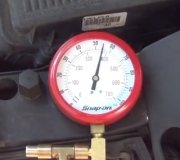Idle speed is controlled by the engine computer. It is supposed to run it up to 1500 rpm for a few seconds when you start the engine, then it will come back down to around 800 rpm.
To understand how to approach an incorrect idle speed, it helps to explain how the system works. There is an idle speed motor that opens or closes a valve as it slowly rotates. That valve controls how much air is going into the engine. The computer places it at the desired position by pulsing its internal electromagnetic coils with varying voltages and polarities. Those positions are called "steps", and there are 256 of them. The higher the step number selected, the more air is going into the engine. At the same time, the computer adjusts how many milliseconds it pulses the injectors open to allow gas into the engine. Slightly longer pulses along with higher idle speed motor steps equals a higher idle speed.
For explaining how we diagnose this, understanding the idle steps is what is important. Those steps are displayed on a scanner. For a properly-running engine, you will typically find it on around step 32. If one cylinder is misfiring, you will find it at around step 50. For demonstration purposes, if six cylinders are disabled on a V-8 engine, it will obviously run very poorly, but the computer has enough control to keep it running at the correct idle speed with only those last two cylinders working. It will be at around step 200.
Now the issue is what is happening when idle speed is not correct. When it is too high, we need to look at the idle steps on a scanner to see what the computer is trying to do. If you see the idle steps are real low, (remember, for this sad story, step 32 is normal), as in step 0 to around step 10, the computer is trying to lower engine speed, but without success. This is almost always caused by a vacuum leak. Cracked and dry-rotted hoses are the best suspects. We find those by pinching them off, then observing if engine speed drops. Sometimes pouring water over the engine when it is still cold will work. Watch for where the water gets sucked in.
If the idle step number is higher than normal, say step 40 to 60, the computer is trying to raise idle speed. If it should not be doing that, we have to look at the rest of the sensor data on the scanner to see what it is responding to. The most important variables are coolant temperature and intake air temperature. Years ago we needed a choke when the engine was cold. That is because less than 100 percent of the gas vaporized in cold weather, and gas that remains a liquid will not burn. We had to dump in extra gas so enough of it would burn to make the engine run right. Today, with fuel injection, a higher percentage of the gas vaporizes properly, but still not all of it when the engine is cold. We still have to add a little extra for the first few minutes until the engine warms up. That is where the computer watches the readings from the coolant and air temperature sensors.
It is our job to see if the readings from those two sensors look reasonable. For example, if it is 40 degrees outside, that is what the intake air temperature sensor had better be reading. The coolant temperature sensor should be reading the same when the engine is first started, but that reading must gradually rise smoothly as the engine warms up. If the two sensors do not agree when the engine is still cold, that is a dandy clue. You have to figure out which one is wrong.
One important tidbit is temperature sensors have an extremely low failure rate because there is just one component inside them. By far more problems are caused by the wiring going to those sensors, and especially the connector terminals. Corrosion between mating terminals in a connector will add resistance which makes the signal voltage go too high. The computer interprets a higher voltage as a lower temperature, and a lower temperature calls for a higher idle speed.
You are at a big disadvantage when you do not have a scanner. You will not know what the computer is seeing or trying to do. The only thing you can do then is search for a vacuum leak. Look for vacuum hoses you can pinch while the engine is running and the idle speed is too high. Start with the largest ones or those closest to the engine. If engine speed suddenly drops a lot when you pinch a hose, follow that hose to where it branches off, then pinch each branch hose to see which one makes engine speed drop. Following hoses this way often leads us to the leak.
Friday, February 16th, 2018 AT 5:28 PM



